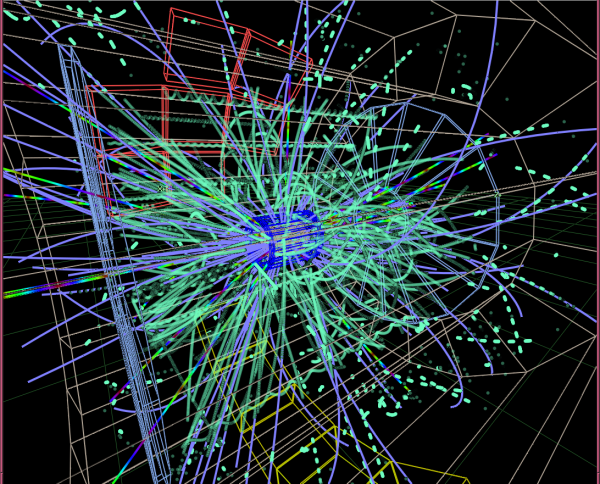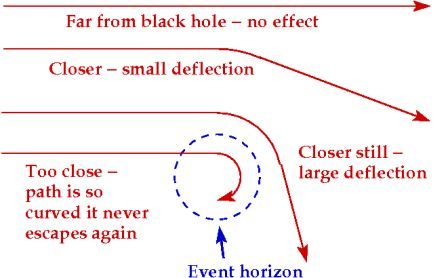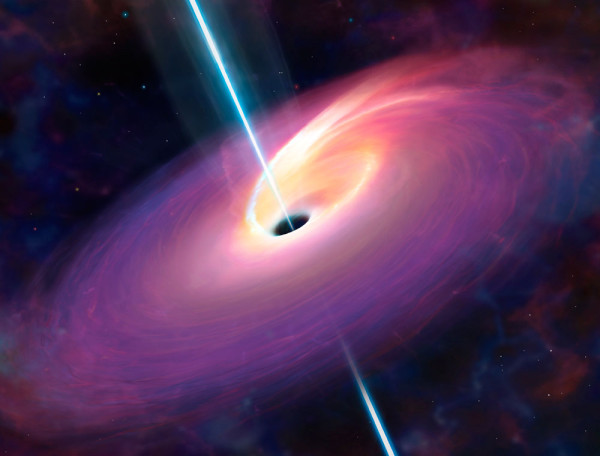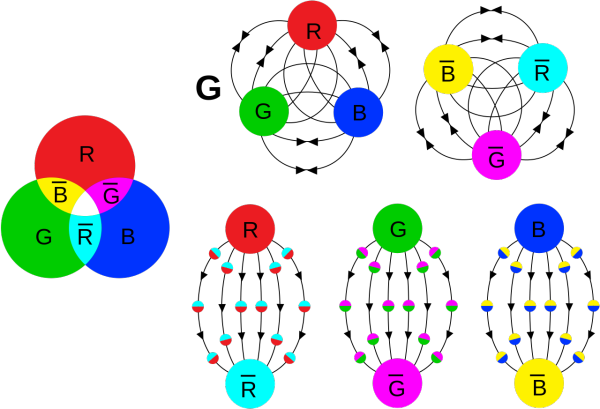"No testimony is sufficient to establish a miracle, unless the testimony be of such a kind, that its falsehood would be more miraculous than the fact which it endeavors to establish." -David Hume
It's sometimes mind-boggling how many different aspects of the Universe we touch on here at Starts With A Bang, and the past week has perhaps really exemplified that. Ranging from the largest scales down to the smallest, from Nobel-winning developments to the science of hundreds of years ago, here's what we've covered during the first week in October:
- Are black holes made of dark matter? (for Ask Ethan),
- A better world, effortlessly (for our Weekend Diversion),
- The brightest Messier globular, M22 (for Messier Monday),
- Why blue LEDs are worth a Nobel Prize,
- There are no free quarks, and
- Why observatories shoot lasers at the Universe (for Throwback Thursday).
You've all had your opportunity to weigh in with your questions, comments and responses at our forum here on Scienceblogs, and now I'm pleased to call out my favorites (and respond) here on our 31st edition of the Comments of the Week!
From MobiusKlein on black holes and dark matter: "Could a super scientist use a black hole as a dark matter detector?
If a super-advanced species built a protective sphere around an existing black hole (say at 1 AU distance) and kept all incoming matter away, would the gain in mass of the Black Hole be detectable over the course of a year?
Or would it be impossible to sufficiently shield it from cosmic rays and the like, so the flux of normal matter would swamp the dark matter flux?"
This is a really fun example of a thought experiment. Yes, it's not practical to surround a black hole with a giant shield, preventing all normal matter, antimatter and radiation from getting in, but surely if we could, we could measure the rate-of-mass-increase of black holes, and detect dark matter indirectly via that method, couldn't we?
I say yes, with a caveat. It's in principle possible to either stop all the matter-and-energy coming in, or at least -- if you can't practically stop it -- to measure the signature of its passage (i.e., its momentum, charge, rest mass and energy) by setting up a detector. This is sort of the reverse of what we do in particle accelerators: rather than measure outgoing particles and their energies, we could measure incoming particles!
 Image credit: Alja & Matevz Tadel, via http://www-f9.ijs.si/~matevz/alice-talks/alice_vizel.html.
Image credit: Alja & Matevz Tadel, via http://www-f9.ijs.si/~matevz/alice-talks/alice_vizel.html.
Whatever's left over that adds to the mass of the black hole would, in fact, be due to dark matter; you'd be able to measure the discrepancy. But I said there was a caveat: we could stop-or-measure all the particles in the standard model, except neutrinos. The dark matter increase we'd measure would be both from whatever the majority of dark matter is and also from neutrinos. If there were some mechanism by which neutrinos somehow made up 100% of the dark matter, we'd never know from this experiment. But so long as we're content with measuring the total black hole increase due to all dark matter -- neutrino-and-non-neutrino dark matter alike -- this is possible. And a fun idea!
Image credit: Jon Turner, of a hyperbolic orbit, via http://ccar.colorado.edu/asen5050/projects/projects_2004/turner/.
From D.C. Sessions on the same topic: "[...] for dark matter; if its original hyperbolic course doesn’t take it into the event horizon it will just continue on the same course and escape [2]. Actually, technically it would never enter the BH anyway, since it can’t lose momentum relative to the BH it would (I’m not sure what) and continue anyway [3]. Or something. Maybe Ethan can explain what happens to the momentum of the DM on a direct collision course."
Oh, Newton, if only your laws were always applicable! If they were, than a dark matter particle that interacted only gravitationally with a central mass, as illustrated above, would have to escape with the same final velocity it entered with, having only its direction altered by the interaction. This simple picture retains its validity so long as the event horizon of the black hole is smaller than the dark matter particle's distance of minimal approach, which it will be almost all the time. But every once in a while, you'll get a dark matter particle whose position (at what would otherwise be closest approach) brings it inside the event horizon, and that's where the trouble begins.
 Image credit: Matthew Francis, via http://galileospendulum.org/2011/06/29/black-holes-dont-suck/.
Image credit: Matthew Francis, via http://galileospendulum.org/2011/06/29/black-holes-dont-suck/.
No matter how much kinetic energy you gain, your velocity when you cross into the event horizon will still be less than the speed of light in vacuum, and this is one gravitational interaction that isn't reversible! Consider, if it helps, the fact that the speed of gravity is restricted to be c, and then consider that once you cross the event horizon, every graviton you emit will wind up at the singularity, pulling you irrevocably towards the center. Rather than the gravitational field spreading out across the Universe, it all conspires to pull you in towards the center.
It's one of the very annoying differences between classical and relativistic mechanics, and it's why even dark matter can be gravitationally captured by a black hole, where it won't be captured by something like a planet, star, white dwarf or even a neutron star.
 Image credit: Charity Engine beta, via http://www.charityengine.com/.
Image credit: Charity Engine beta, via http://www.charityengine.com/.
From See Noevo on the topic of charity: "Did you know that studies have shown that conservatives give more to charities than liberals, both in absolute dollars and as a percentage of income?"
Does this mean that -- whether you're a liberal or conservative -- you are going to participate in the Charity Engine project? Actually, I was curious whether this statement was true or not, so I decided to look into it. Here was what I found, with my sources being these five articles linked here. The results:
- The 17 most charitable states all voted republican in the last presidential election, while the 7 least charitable states (donations as a percentage of income) all voted democrat.
- "Charitable donations" include religious donations; if you account for churchgoing as a factor in the charitable analysis, democrat/republican differences disappear, and that the "least generous" states and cities have higher taxes that generally provide the same services.
- "Red states" gave more to religious charities, but "blue states" gave more to secular and international charities.
- When partisanship was assessed using an actual political quiz instead of social conservativism/liberalism proxies, there was no difference between charitable donations from the left-and-right-wings.
- "Strong" Democrats were more than twice as likely to volunteer frequently to support a charity than any other group, including independents.
- And apparently, how you solicit funds has a dramatic impact on whether democrats or republicans will donate to your cause. From the last article linked:
“We found that while both Republicans and Democrats tend to equally value justice and caring for the vulnerable, Republicans place a much higher value on issues of purity and respect for authority,” said Karen Page Winterich, study co-author and assistant professor of marketing at Pennsylvania State University. “Given these differences, Republicans are more inclined to donate to a charity when these values of purity and respect are met, whereas Democrats are more inclined to donate when the emphasis is purely on equality or protection rather than respect or purity.”
All of which is to say, I didn't think your comment was relevant to the article, See Noevo, nor did it provide useful information other than announcing, "I am a conservative and here is a (disputable) fact that says conservatives are better than liberals and therefore I am better than liberals." We can all do better than that.
Image credit: R. Columbari, via http://asterisk.apod.com/viewtopic.php?t=31833.
From Julian on our last Messier Monday globular cluster: "Yet another awesome post, absolutely love this Messier series, can’t believe we’re almost finished!"
It will officially be two years since I started the series later this month, and I think we've all learned so much about the Universe and the variety of objects in it that are visible, prominently, in our night skies from it. (I know I certainly have!) For those of you who were wondering what inspired it, eight years ago I gave a talk at Vanderbilt University about the evolution of electromagnetic fields and charges in the Universe, where then-assistant-professor Rob Knop saw a picture of a galaxy I put up and noted that I had said it was M87.
And he corrected me, telling me it was M81 and not M87. I was pretty sure I was right, but it wasn't important to my talk. "I bet you a nickel," he said. Agreeing, I moved on and gave the rest of my talk. A week or so later, I sent him a check in the mail for a nickel. Even though my expertise was in theoretical cosmology, I felt it was something I should know, and that the entire Messier catalogue was something I should better know, and so when I decided I wanted a Monday series, Messier Monday was the way to go. And thus, in 2012, Messier Monday was born of that memory. When the series is complete, it will always remain on the internet, so if you ever want to reference our take on these 110 objects, it'll be there for you! I also recommend checking out the SEDS Messier catalogue's reference on each object, Universe Today's series, and the Wikipedia entry. (But reference Starts With A Bang first; I'm pretty positive we've got them all beat in terms of quality!)
Image credit: Fun Flashing LEDs, via http://www.funflashingleds.com/clear-light-up-glow-cube-with-blue-led.h….
From Solid State Physicist on the topic of blue LEDs: "Granted, it was a huge breakthrough and the number of applications are enormous. And these scientist have undoubtedly done fabulous, meticulous work.
Is it a breakthrough in physics, though? I would argue, no, it wasn’t. I would categorize this work squarely in (materials) engineering. This is in contrast to the invention of the transistor, where a lot of the condensed matter physics was still unknown. The physics of the LED? Not so much."
I have a hard time understanding why someone says that this new development in science, made by physicists pushing the boundaries of physical systems past the point that had previously reached, isn't physics. I mean, there are plenty of physicists working in this field who, you know, call themselves physicists (like this guy, or this guy), and yes it's in materials science, but so is all of solid state physics.
Maybe I don't understand why "solving the hard problem," which is what inventing the bright, blue LED did, isn't worth the reward of a Nobel Prize from your point of view? It required developing a new technique for constructing a new type of semiconductor to create a never-before-seen type of junction in a diode, and then improving that technique to get the desired result. Saying, "it isn't physics" when it clearly is one of the three major branches of modern physics research (condensed matter, particle and astro) just baffles me.
And finally, from Omega Centauri on the topic of free quarks: "Gravity and electrostatic forces are in some way fungible or global. If I have a charge at some point P, and another opposite charge a short distance away, I can compute the effect an arbitrary distance away by summing the one over r squared forces separately, i.e. the elect[r]ostatic force at any point is a linear superpos[i]tion of forces from all the charges in the universe. If I think about trying this for a strong force which grows exponentially with distance I’m going to have a big problem. Is the strong force somehow restricted in terms of which quarks it applies to?"
The fun thing about the strong force is that the force I described -- rising as distance increases -- only applies to system with a net color charge, and describes the strong interaction within a bound system, like a nucleus. When you have "confinement", i.e., a colorless entity, then the force between nuclei drops off according to a Yukawa potential, which is like a Coulomb potential except with an exponential suppression on top of it. This is why the strong nuclear force, outside of colorless entities like protons, is so mind-bogglingly short-range! Gluons may be massless, but the force carriers that interact between colorless entities are other colorless entities: virtual mesons!
Because these have a real, positive (and quite large) mass, they're extremely short-range. It's this dual nature of the strong interaction -- incredibly powerful when there's a net color charge, but falling off dramatically when you're color-neutral -- that makes the strong force behave as it does. There's an excellent review here if you want more (technical) detail.
And thanks for a (mostly) excellent week of comments, everyone! See you next week!
- Log in to post comments



